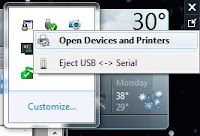As a new ham, I purchased my first HT at a recent swap: a used Icom IC-T8A. And it's worked fine for me so far. But while reading the manual, I noticed that the memories could be programmed with alphanumeric labels. However, in order to do this you need an OPC-478 cloning cable and the CS-T8 cloning software.
Fortunately, my father had the USB version of the cable (OPC-478U) in his collection, and loaned it to me. The CS-T8 software was (thoughtfully) included on a USB flash drive I got with the radio (along with the manual in .pdf format, and several other bits of documentation.)
So I plugged the USB cable into my PC, and Windows 7 installed drivers without prompting me. Then I connected the other end of the cable into the radio, set the radio to CLONE mode, and double-clicked on CST8SU.BAT to start the software.
D'oh! The software is old 16-bit DOS, and my 64-bit Windows 7 won't run it. As it happens, I play a bunch of old DOS games on my PC, and know just how to get around this:
DOSBox. DOSBox is a DOS-emulator that runs fine on most any modern version of Windows. So I downloaded and installed the latest version from the web (I was a couple minor revisions out of date), now I needed to know what serial port was being emulated by the USB cable.

To do this, I clicked the downward triangle that's the new Win7 system Tray, then right-clicked on the USB icon and chose "Open Devices and Printers". Double-clicked the "USB <-> Serial" Icon, then selected the "Hardware" tab. Here is where the COM port being emulated is listed (in my case, it's COM3):

Armed with this info, I needed to update the dosbox.conf to use this virtual serial port. I added the following line to my config:
serial1=directserial realport:com3
This line basically says that the DOSBox serial port 1 (COM1) should be mapped to the Windows 7 COM3. Then I copied the TC8A software into the DOSBox directory (I put it in a ./TC8A folder), and started DOSBox. I then connected the cable to the radio, and started the radio in CLONE mode.
At the "C:" prompt, I typed 'TC8ASU' to start the software:
I selected "Read from Port #1" since I'd emulated Serial 1 in the dosbox.conf file. Then I had to put my callsign in. The software starts up, and I'm able to reprogram my HT from the software, even though it's too old for Win7 to care.
This method should work for most any older DOS-based software. Check out the DOSBox website for more info, but it's my preferred tool for situations like this, particularly since i can map directly to existing hardware for serial connections.
 Last week's adventure was a trip to the Pyri Funfair, which was a hoot. We started with a dozen or so Goonies, and kept getting separated through exploration, and deaths. Eventually, it was Kit and I exploring together; running across other Goonies off and on. But we finally made it down through the tunnels, and found the Prim of Life. That's me on the left, in the awesome explorer's hat I found, and Kit, my companion for this adventure.
Last week's adventure was a trip to the Pyri Funfair, which was a hoot. We started with a dozen or so Goonies, and kept getting separated through exploration, and deaths. Eventually, it was Kit and I exploring together; running across other Goonies off and on. But we finally made it down through the tunnels, and found the Prim of Life. That's me on the left, in the awesome explorer's hat I found, and Kit, my companion for this adventure.


